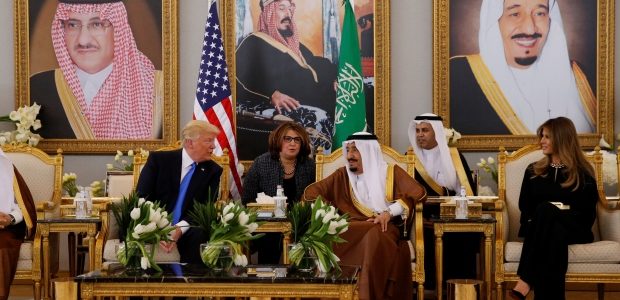It was 12th December, 2015 when Donald Trump tweeted about how the Saudi Prince’s public criticism of him was due to the fact that the Saudis would not be able to control the US political discourse using their oil money. A year and a half later on 20th May, 2017 he signed a $350 billion arms deal with the same Saudis from which $110 billion was immediately transferred. As the French say Qui Viva Verra, meaning whoever lives long enough, knows how quickly things change.
When it became apparent that the US 45th President’s first official foreign visit would be to the Kingdom of Saudi Arabia, there were hints of both anxiety and intrigue. President Donald Trump had been vocal against what he called the growing sphere of influence Saudi Arabia was exerting over the region. As a result of this and the donations made by the Saudis to the Clinton Foundation, there was a negative influence on the journalists. Throughout his vitriol against Hillary Clinton, funding of the Clinton Foundation by the Saudis remained the most intense hammer used repeatedly to win the debate. A poll by Associated Press revealed that most American voters that shunned Hillary Clinton was because of her ties to Saudi Arabia’s money. Ironically, Mr. President’s first major piece of diplomatic tête-à-tête is with the same Saudis, that too with a significantly greater sum involved than it ever was with the former Secretary of State.
Eyebrows were raised in Washington’s political circle when it was revealed that the Commander-in-Chief would also address the Kingdom of Saudi Arabia (KSA) regarding Islam. If one can recall, Trump’s rhetoric against Muslims and its supposed incompatibility with the Western values was another bedrock of his campaign. On the day of the address, the new President’s strategic interests were clearly identified, portraying a different picture then that of his campaign. The President of the US singled out Iran as being the rogue state of the region, committing that the US would take any measures required to maintain the regional stability of the Middle East. In his address, Trump further reiterated the US support not just for the KSA but its allies’ bloc formed as a counteract for Iran.
This policy signals a dramatic shift in the US diplomatic stance on the region. Whereas the Obama administration preferred neutrality, Trump’s reign is firmly siding with the KSA. Trump administration is of the view that the P5+1 limits its nuclear program significantly while allowing Tehran more economic mobility which is equally outrageous for the region. While the Obama administration effectively brokered the deal, President Trump does not share the same sentiments. Against the previous regime’s policy of striking balance, the current President’s camp is more devoted towards isolation of Iran and bringing balance by empowering the Saudi bloc. Something that was ostensible when Trump recapped Iran as the collective antagonist of the world, calling for a complete boycott of it.
Furthermore, the most interesting part is that Hassan Rouhani conveniently won the recent elections, elected as the Iranian President once again. The Rouhani regime is known as the reformist camp that needs reconciliation with the international arena and these elections signaled that citizens of Iran welcomed this approach. Rouhani was the architect of the nuclear deal with Americans and Europeans in order to bring Tehran out of its isolation. This deal furthermore has opened the economic gates and gives access to frozen assets worth billions of dollars to Tehran. It is pertinent to mention that the benefits of the deal are limited due to the fall in global oil prices and the election of Donald Trump as POTUS. The US already sanctioned Iran for their ballistic missile test whereas President Trump has repeatedly threatened to rip up the nuclear deal.
Assessing the US foreign policy, Trump administration is returning to hard geopolitical realism; a retreat from the idealistic approach of Democrats. The arms deal of $350 billion indicates that the United States of America is having a two-pronged strategy. This strategy contains “Deterrence” and “Cohesion” policies for adversaries and alliances in the Middle East. The multi-billion arms deal is not only with Saudi Arabia but also the Sunni bloc in the Middle East. Selling the arms to the Sunni bloc is the cohesion policy whereas putting sanctions on Iran and providing a nuclear umbrella to the Sunni bloc is the deterrence policy. Such a Republican turn in foreign and security policy for the Middle Eastern region clearly disturbs the balance of power in the region. The deal is a clear indication that the US is supporting the Sunni bloc because the foreign policy of the traditional allies i.e. Egypt, Israel and Saudi Arabia were very independent during former President Barrack Obama’s tenure.
Analyzing President Trump’s visit and the arms deal, the deal is important for the military and the rejuvenation of the US economy. President Donald Trump highlighted the decline in the US military industrial complex when he accepted the Republic nomination for President in June 2016. He promised that he would restore the diminishing importance. His visit to the Saudi Arabia indicates that President Trump is fulfilling one of his campaign promises. Something that seems rare in the present circumstances.
From Saudi Arabia, President Trump will now fly to Israel where he is expected to make a similar address highlighting and elaborating on what his administration’s policy will be. He will travel to Jerusalem for meetings with Israeli officials, as well as a visit with Palestinian President Mahmoud Abbas in Bethlehem. His next stop will be Rome where he will have a private audience with Pope Francis. Furthermore, President Trump has announced that he will revive the stalled Israeli-Palestinian peace process. The most interesting part is that the US President will have visited significant homes of three major religions by his trip’s end Islam, Judaism and Christianity. While the world watches with intrigue, Iran on the other hand waits with apprehension.
